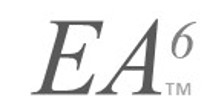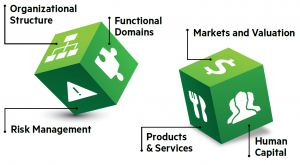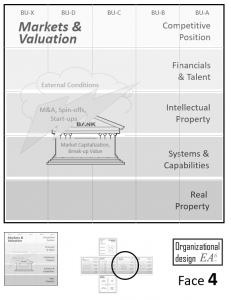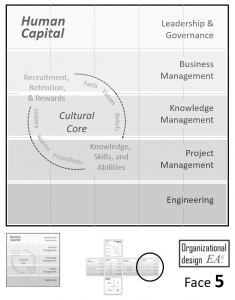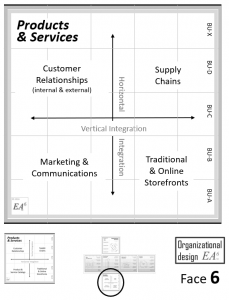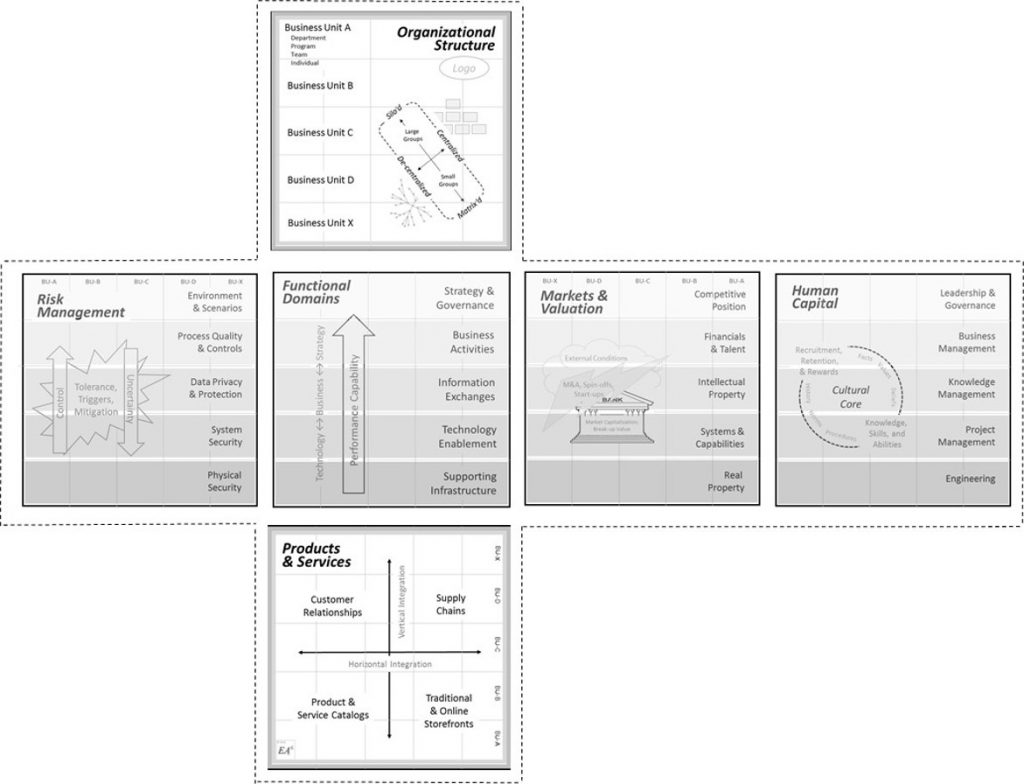Introducing EA6
Organizational Architecture & Design (OAD) is a holistic management discipline which deals with enterprise transformation. It is especially helpful in periods of restructuring, such as Mergers & Acquisitions.
OAD extends Enterprise Architecture beyond structuring, to include organizational health/viability. The EA3 Cube Framework is used but now enhanced to include areas for risk management, human capital, and valuation. The updated/new framework is therefore called EA6.
The Six Faces of the Enterprise
The OAD Framework is a “real” cube with six faces. The six-faced OAD Framework includes analysis and design areas for:
Our claim is that these exact six views into an enterprise are interrelated in a complex way. In popular terms, we could say that there are always six sides to a story.
Organizational Structure
Depicts the major business units (BUs) that make up the organization.
Reporting relationships between governance bodies and the BUs are usually depicted through an organization chart and a role/responsibility matrix.
Types of BUs include subsidiary whole companies, internal divisions, departments, stand-alone and integrated lines of business, program and staff offices, cross-functional teams, contractors, and independent workers. External groups may also be depicted if there is a persistent relationship. Oversight of BUs is achieved by centralized or decentralized (federated) governance methods.
Functional Domains
Depicts the major performance capability areas of an organization, presented hierarchically in sub-architecture domains.
The relationship of these domains is that strategic goals drive business activities/information exchanges, which are enabled by technology systems that are hosted on networks and in facilities. There are industry best practices at each domain level that help with effectiveness and efficiency, but which need to be selected and used with the whole organization in mind. There may also be government regulations and resource constraints that must be factored into plans and projects.
Risk Management
Depicts key areas of risk in each functional domain and in the BUs. Organizations want to eliminate or limit disruptions that effect mission success or profitability.
Risk derives from uncertainty in predicting or dealing with disruption. Mitigation centers on the avoidance or response actions. Tolerance reflects the acceptable level of exposure to a certain type of disruption and the negative effects that would result. A trigger is something that causes a disruption event.
A holistic approach to managing risk begins at the enterprise level and completes with more detailed procedures at the BU and program levels.
Markets and Valuation
Depicts the public and private sector markets and/or mission areas that the organization is active in.
For private sector organizations this is the market’s valuation (stock price) versus the aggregate sale value if broken-up. It is also the anticipated value increase or decrease from mergers, acquisitions, start-ups, and spin-offs, as well as a comprehensive balance sheet of monetized assets and liabilities in each business unit.
For public sector organizations it is the liquidation value of all tangible and intangible assets.
Human Capital
Depicts the knowledge, skills, and abilities (KSAs) needed in each functional domain of the organization. The KSAs are different for executives, managers, and staff in each area.
There is a “cultural core” in each organization that is comprised of the values, norms, beliefs, facts, history, traditions, and methods in each BU and program area.
Cultural norms create informal power centers, communication channels, and processes.
People are often thought of as the most important and valuable resource of any organization, so full-lifecyle (hire-to-retire) talent management is very important.
Products & Services
Depicts the tangible or virtual products and services that the organization provides to internal and external customers.
Mission success and profitability are maximized through a holistic approach to delivery with a focus on vertical/horizontal process integration within/between BUs.
Key areas of focus include customer relationships, end-to-end supply chain management, onsite/online store efficiency, and marketing/communications effectiveness. Architecture methods can help to identify gaps and overlaps, process improvement and reengineering projects, managing change, and handling disruption.
EA6 in QualiWare
Organizational Structure
In QualiWare, you can model the Organizational Structure using the OrganizationDiagram. It is built using OrganizationUnits which can be enriched with links to Positions that are responsible for a given unit and Roles that can be linked as resources for the unit. Each unit can be broken down into one or several OrganizationDiagrams. This enables you to model a large and complex organization and responsibility structure.
Functional Domains
Risk Management
Environment & Scenarios
There are several useful reports for risk management available in QualiWare. They enable you to see the full context of the environment the risk are situated in. This includes where the risk occurs, what actions are taken to remediate them, what their residual significance and likelihood are, as well as who is responsible for handling the risk:

